Join me on a trip down memory lane as we take a look at the history of Battlefield on PC
A friend introduced Swedish college student Andreas Axelsson to The Silents, a demo group of graphic artists, programmers and musicians, in 1992. Axelsson soon decided their avant-garde style of computer-animation wasn’t his speed, and he pulled a trio of fellow Silents aside for a slightly different project: a pinball simulator with realistic physics. They coded Pinball Dream on Amigas in a rented summer cabin for fun. Mid-way through, they realized they could sell their game for money.
The group spent a night coming up with a faux-company name to put on the box, settling on Digital Illusions Creative Entertainment. None of them had graduated college yet.
One vastly successful Pinball Trilogy later, DICE stopped being a hobby. They staffed up, moved their Amigas from apartments to offices, and moved into hardcore territory with BAFTA-nominated racing game Motorhead. Then they saw what fellow Swedish developer Refraction Studios — founded by another group of college students — was up to.
Released in 1999, Codename: Eagle cast Russia as the aggressor in an alternate World War II. It didn’t stand up against the competition — notablyElectronic Arts‘ Medal of Honor, released the same year– but the DICE team saw potential. By the time the two studios merged under the DICE banner in 2000, Refraction was already knee-deep in a follow-up that cut far closer to their original vision for Eagle. Lars Gustavsson, an artist hired to work on Eagle, served as its project leader…this would be his second professional credit. They called it Battlefield.
Battlefield put infantry, boats, vehicles, and planes all on the same online map — based on the defining battles of World War II — then unleashed up to 64 trigger-happy gamers. The default Conquest mode sent teams to capture and hold control points, while a character class system gave players defined roles to encourage teamwork.
It became entirely possible to shoot your way to a broken jeep, repair it, find a plane, dive bomb enemy infantry, then commandeer a battleship at sea to shell the opposition back on land. In terms of sheer scale, nothing else came close.Only DICE couldn’t find a publisher. PR agents came up empty, and a demo built for E3 on the old Codename: Eagle code failed to capture any interest.
Gustavsson pushed onward, fine-tuning the balance and even throwing in submarines well after the game passed Alpha stage — traditionally the cut-off point for adding new content — to go along with the other 30-odd playable vehicles. Everyone inside DICE knew their game was magic. It seemed like nobody else felt the same way…until Electronic Arts came knocking.
The EA Connection
QA testers at EA’s Redwood Shores campus had gotten hold of the E3 demo and played it every day on their lunch break. The publisher had just released WWII shooter Medal of Honor: Allied Assault, but when word reached management, they set their sights on Battlefield.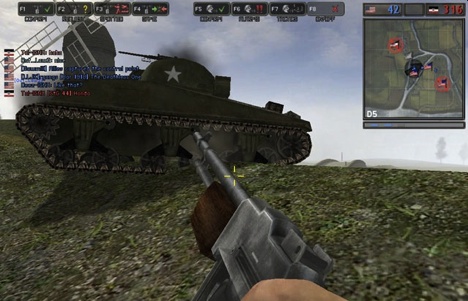
In late 2002, a decade after Pinball Dreams, EA and DICE hosted a review event for Battlefield: 1942 on the flight deck of the USS Hornet, a retired aircraft carrier berthed in Alameda, CA. Journalists battled it out on a 64-player LAN connection, surrounded by real fighter jets. Graphically, the game didn’t break any new ground, and the single-player campaign felt laughable, but everyone left with zero doubt in their mind that they’d just played a genre-defining title and the PC game of the year.
Just 13 months later, Activision released its own WWII shooter: Call of Duty
DICE, a niche company known for racing and licensed games, shot to the major leagues overnight. Two expansion packs, The Road to Rome and Secret Weapons of WWII, kept players busy while a true sequel took shape.
Gustavsson wanted Battlefield to stick to real-world conflicts, but an over-saturated WWII shooter market ruled out a return to that war. They settled on Vietnam mainly by default — an interesting conflict in the 20th Century — and passed work over to DICE Canada. The studio that produced Wham-O Frisbee Golf and Shrek: The Video Game took the reins for 2004’s Battlefield: Vietnam.
The setting and a 20-year bump in military technology promised an interesting new take on the Battlefield formula. That didn’t happen. Flamethrowers and destructable environments were discussed, then rejected. Players could strafe ground targets in a chopper while blasting The Ride of the Valkyries, Apocalypse Now-style, or watch Viet Cong regulars headbang to ’60s rock ‘n roll, but it felt like a mod, not a sequel. Dense jungle maps made ground vehicles impractical, even useless, and class balancing went completely AWOL.
A month before its release, EA announced its intention to acquire DICE outright. The company obtained a controlling stake in early 2005, just as the team dug in for the final push on Battlefield 2.
Gustavsson still favored real-world settings, but EA wanted a modern-day Battlefield. The team took inspiration from 1942’s popular Desert Combat mod, which added RPGs and fighter jets to the old World War II battles. To this, DICE added a new in-house game engine, a fictional America/China/Arab conflict, a massive array of 21st Century ordinance, and the new Commander mode. One player on each team oversaw the entire map, designated targets, and called in vehicle drops or artillery strikes. Combined with newly refined classes, player teamwork solidified
Single player, however, merely swapped multiplayer buddies for iffy bots, and despite standouts like Strike at Karkand, the fully scalable maps lacked 1942’s diversity. Bugs and glitches also plagued gamers despite a two-month release delay.
None of that stopped Battlefield 2 from being the sequel everyone wanted. DICE had planted another flag in the shooter arena…one others would soon follow.
Battlefield itself, however, moved even further forward. Even as B2 expansions Armored Fury and Euro Force dropped, rumors and recurring Easter eggs pointed to a number: 2142.
Into the Future
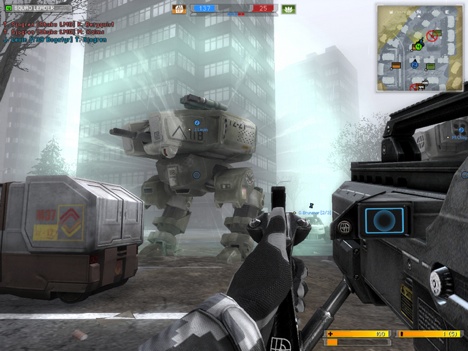
Having manufactured a conflict for Battlefield 2, Gustavsson — now DICE’s creative director — decided to create an entire setting from scratch. The team played around with a Russian/American war set on an entirely different planet for about a month before bringing things back to Earth. They wanted something grounded — no rayguns — even if skirmishes involved MechWarriors and hovercrafts.
Battlefield 2142’s armies fought in the face of an impending ice age. But like Vietnam two years before, 2142 felt like a reskinned version of past Battlefields, only with smaller maps, fewer classes, and a tougher learning curve. Players could knife enemies and permanently steal dogtags, but few connected with the sci-fi setting. Worse, rumors swirled that the pervasive in-game advertisements acted as spyware. That proved false, but the game did monitor which ads players lingered on. Fan outrage and good-but-not-great reviews made 2142 something of a letdown. The Northern Strike expansion didn’t provide much remedy.
Meanwhile, EA completed its acquisition of DICE and quickly shuttered DICE Canada. To everyone’s relief, EA left the rest alone. But in 2007, Call of Duty 4: Modern Warfare completely eclipsed the entire first-person shooter genre. If jumping to a future war seemed risky, now DICE had to take even bigger gambles with its only franchise.
Bad Company
DICE had always prided itself on a PC-first approach. Few of its console games impressed anyone, and a stripped-down port of Battlefield 2 for the Xbox 360 failed to live up to its namesake. But with the PC market waning and shooters escalating on consoles, it was time to rethink everything. The new Battlefield would have a dedicated single-player campaign, destructable environments — thanks to the all-new Frostbyte engine — and shockingly, no PC release.
2008’s Battlefield: Bad Company followed a four-man squad of dedicated screw-ups going rogue to steal enemy gold. Few things could beat collapsing an entire house to rid yourself of one pesky sniper, but vehicle integration felt light compared to past Battlefields, and the darkly humorous cast of crazed rednecks and deposed dictators didn’t win everyone over. Bad Company did its part but, financially speaking, hardly rated as a challenger to Modern Warfare.
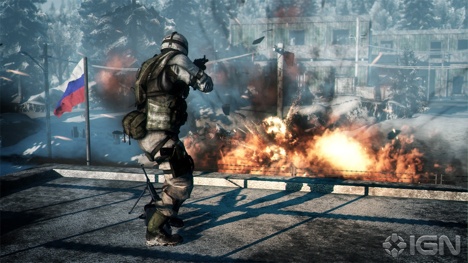
Once again, DICE re-assessed. Destruction worked. The story didn’t. A shallow treasure-hunting plot lacked Modern Warfare’s nuclear-terrorism gravitas, and Modern Warfare 2 only upped the stakes from there.
Battlefield: Bad Company 2 followed suit, ditching the humor to go hunting for a loose WMD. That went hand-in-hand with a renewed focus on vehicles and multiplayer, the franchise’s other great strengths. Central to the plan: the all-new Rush mode, an evolution on the old Conquest game that assigned teams to attack or defend key points, advancing or retreating across colossal maps as the fortunes of war changed. DICE even took players back to Vietnam in a downloadable expansion. Flamethrowers came standard-issue, and in response to fan outcry, a dedicated team brought it all home to the PC.
This time, everything clicked. Bad Company 2 couldn’t match Call of Duty’s stratospheric numbers, but did rival its popularity among online players and sold more units than any other game in the series by a wide margin. Rush became the new mandatory online mode for every shooter. Nominations and awards piled in. Battlefield was back.
Not that it ever really left. Between Bad Companies, DICE and Easy Studios — another EA-owned developer, specializing in free-to-play games — released Battlefield Heroes, a cartoony, third-person take on the franchise. While it garnered a strong following and fair reviews, 1942 returned as a stripped-down, $15 console downloadable. Battlefield 1943 remastered the original on Bad Company 2’s Frostbyte engine and became one of the most successful downloadable games in console history.
Into the Present
As DICE approaches its 20-year anniversary, the company has only just started to diversify its resume again. It produced a cult hit in first-person parkour game Mirror’s Edge, then took on multiplayer duties for EA’s Medal of Honor relaunch, closing the circle that began way back with Codename: Eagle. But Battlefield remains the signature franchise and first among its priorities.
In partnership with Neowiz Games, DICE broke into the South Korean PC market with Battlefield Online, a remake of Battlefield 2 built on Battlefield 2142’s engine. For Western markets, Easy Studios returned to build Battlefield Play4Free, EA’s flagship freemium online shooting gallery, from a BF2 base with Bad Company 2 assets thrown in. Both gave Battlefield new audiences, but more importantly, they freed up teams at DICE to work on what they considered the first core franchise entry since 2005.
In March 2011, EA and DICE invited journalists to an exclusive first look at an early level playthrough of Battlefield 3. It amounted to roughly ten minutes of thunderous sound, intense action, a brutal fist-fight, and several collapsing skyscrapers. For a coup de grace, DICE finished with an old-school William Castle gag: a vibrating floor under the audience to simulate the city-shattering earthquake that closed out the demo.
On November 5, 2010, EASY Studios announced a follow-up to its free-to-play Battlefield Heroes, Battlefield Play4Free. EASY develops the free-to-play variants of Battlefield. Its latest offering gives players the same free-to-play pricing structure of Heroes, while still offering a more serious, core Battlefield experience (as opposed to Heroes‘ lighthearted, cartoon-styled environment). Battlefield Play4Free went into open beta on April 4, 2011.
On July 17, 2012, an advertisement appeared on EA’s Origin webpage that players who pre-order Medal of Honor: Warfighter, would receive access to an exclusive Battlefield 4 Beta. Battlefield 4 was announced on March 26, 2013. A Beta for the game began on October 1 and ended on October 15. It was released on October 29, 2013.
Information about the next entry in the series, Battlefield Hardline, was leaked on May 27, 2014, and officially unveiled on June 9, 2014, during E3. The game was developed by Visceral Games and, unlike previous installments in the franchise, is centered around a cops-and-robbers theme.
In July 2015, CFO of EA Blake Jorgensen announced a new Battlefield title will be released in 2016.This has been followed up by Dan Vaderlind, EA DICE Development Director, announcing that since Star Wars: Battlefront has been released, he will now be focused on the upcoming Battlefield title.
Source: IGN/EA/DICE/JACKFRAGS

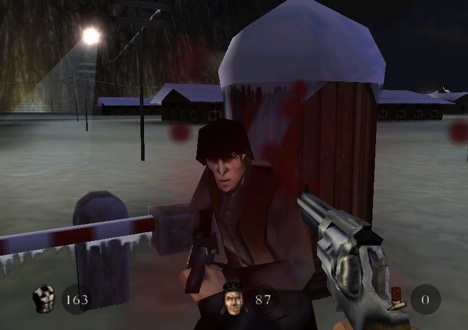
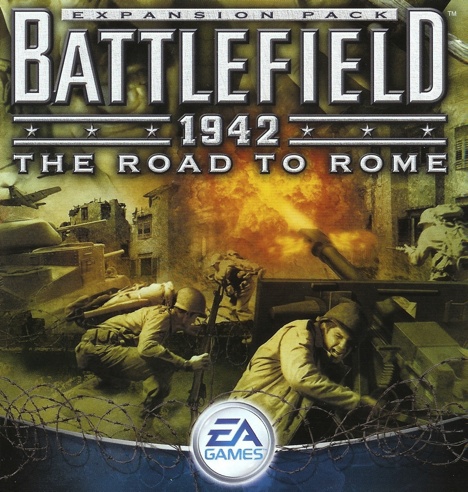

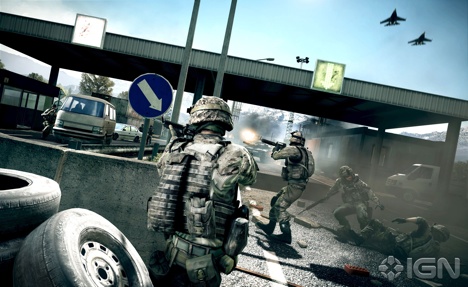




Leave a Reply
You must be logged in to post a comment.